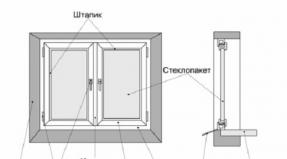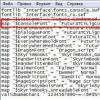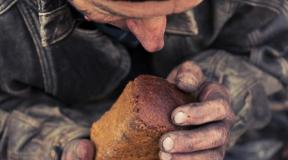The dog swallowed a bone - what to do? Foreign body in a dog How to tell if a dog has swallowed a foreign body
Dogs are naturally very curious. but sometimes their curiosity leads to disaster. This is especially true for dogs - "vacuum cleaners" that eat a lot of strange things. what items the doctors of our clinics did not get from the digestive tract of dogs - socks, underpants, bags, ropes, threads, needles, toys, bones, sticks and many other finds!
Foreign body symptoms in a dog are highly dependent on whether the object is in the mouth, throat or esophagus, stomach or intestines.
Foreign body in the dog's mouth - usually sticks or bones that are stuck between the dog's back teeth. One of the first signs is frequent jaw movement, profuse salivation, the dog rubs its muzzle with its paws, and there may also be slight bleeding from the mouth. Don't try to remove the stick or bone yourself! Even if you succeed in weakening the object, it may move into the throat. Contact the nearest veterinary clinic "Your Doctor", a doctor's examination is necessary, sedation may also be required to remove a foreign body from the dog's mouth.
A foreign body in a dog's throat often causes symptoms of sudden suffocation and nausea. this condition often requires urgent intervention! As a first aid, the owner can lift the dog by the hind legs and shake it in emergency you can sharply squeeze the chest from the sides several times.
A foreign body in the dog's esophagus: signs - vomiting after eating, dehydration To check whether your animal is dehydrated or not, collect the skin fold on the dog's withers and release it, it should return to normal position quickly.
When a foreign body in a dog's trachea and lungs, the general oppression of the animal grows at an alarming rate. You must immediately consult a doctor!
A foreign body in a dog's stomach is more difficult to diagnose. Some foreign bodies can remain in the stomach for several years without visible problems. But if the foreign body moves, it can lead to intermittent vomiting.
A foreign body in a dog small intestine usually causes indomitable vomiting, dehydration, severe pain in the abdominal wall.
A foreign body in a dog's rectum: if these are sharp objects, sticks, bone fragments, needles, etc. - the dog is repeatedly hunched over, constipation is possible, blood in the stool. It is important for owners to follow the rule: never pull a foreign object that is protruding from your pet's rectum! It can be very dangerous, up to and including rupture of the intestines. Contact the nearest veterinary clinic "Your Doctor".
A foreign body in a dog. Causes and symptoms
Almost all gastrointestinal foreign bodies are items that are consumed by animals. One exception is trichobezoars (hairballs). The threads and ropes swallowed by your dog are often wound around the root of the tongue. Examine your pet's oral cavity carefully!
Symptoms for which you need to contact your veterinarian:
- Vomit
- Diarrhea
- Abdominal pain
- Anorexia (no or decreased appetite)
- Straining during bowel movements, constipation
- Lethargy
- Dehydration
A foreign body in a dog. Diagnostics
Diagnostics requires general analysis blood, biochemical analysis blood, urine analysis. These findings help rule out other causes of vomiting, diarrhea, anorexia, and abdominal pain. It is imperative to perform X-rays using a contrast agent.
A foreign body in a dog that causes intestinal obstruction, prolonged vomiting, diarrhea can lead to significant metabolic changes in the body. In addition, a foreign body can cause perforation of the organ wall and exit into the chest or abdominal cavity leading to profound complications such as peritonitis, sepsis and death. Many foreign bodies are composed of toxic materials that are absorbed by the body - this leads to deep systemic diseases.
A foreign body in a dog. Treatment options
There are several treatment options available depending on your dog's condition. If you have recently swallowed a foreign object, you may try to induce vomiting. It is also necessary to drink mineral oil, which facilitates the passage of foreign bodies through the gastrointestinal tract within 48 hours.
Some objects can be removed with an endoscope. If the animal has symptoms such as vomiting of blood, severe pain, then intravenous infusion and the introduction of pain medications are necessary. Your veterinarian will suggest hospitalizing your dog for observation at the clinic. The decision about the operation is made, as a rule, on the basis of X-rays and ultrasound results. A blockage in the intestines or stomach can reduce blood flow to the gastrointestinal tract tissues, which may become necrotic. If the foreign body is in the stomach or intestines, the object is removed by making an incision in the intestines or stomach. If there are necrotic tissues and parts of the intestine, they are also removed.
After the operation, intensive therapy is carried out with intravenous administration liquids, injected painkillers, antibiotics. Feeding the dog after the operation begins in 1 - 2 days. It is advisable to use special dietary rations for the first time.
A foreign body in a dog. Forecast
In most cases, dogs with foreign bodies that do not cause blockages have a good prognosis. However, in general, the forecast depends on several factors:
- property location
- duration of occlusion caused by object
- size, shape and characteristics of the object
- whether or not the object will cause secondary diseases
- general state the health of the dog before the ingress of a foreign body
A foreign body in a dog. Prophylaxis
- eliminate bones from the diet
- don't let your dog gnaw on sticks
- watch the animal during games and walks, if the dog is prone to vagrancy wear a muzzle on it
- Ask your veterinarian for advice on choosing toys that are harmless for your dog.
- if the dog often eats strange objects, consult the doctors of our clinics, possibly a general metabolic disorder
And remember - your pet's life is in your hands.
Various third-party objects (bones, plastic bags, toys, peas, beads, needles, pieces of glass, rubber balls, items of clothing, buttons and other foreign objects) may end up in the ears, between the pads of the paws, in oral cavity, pharynx, esophagus, gastrointestinal tract, thereby causing the dog unpleasant, pain and severe discomfort. In severe cases, foreign objects in the body of your four-legged friend can cause intestinal, pulmonary bleeding, provoke the development of inflammatory processes in various organs and systems of the body.
Most often, foreign objects enter the dog's body during active games or changes in behavioral reflexes, which may indicate the development of any abnormalities in your dog's body (rabies, Aujeszky's disease, nervous disorders). Often the owners themselves are to blame for this behavior of the dog, who allow the pet to pick up inedible objects from the ground, or when leaving the house forget to hide small and dangerous objects for the dog's health that the puppy can taste. Symptoms and manifestations, which indicate the presence of a foreign body in the animal's body, depend on the place of its localization and the duration of its stay in the animal's body. It is worth noting that the danger lies in the fact that foreign objects can get stuck in any part of the gastrointestinal tract, while the symptoms may not appear immediately.
In any case, you should immediately contact your veterinarian or take the dog to the veterinary clinic for examination!
Foreign objects in the throat, esophagus of the dog
Difficulty breathing, coughing fits, refusal of food, water, anxiety, the dog rubs its muzzle with its paw, constantly clears its throat, cannot bark, note vomiting, nausea, increased salivation (hypersalivation). Fever, soreness and swelling in the throat area are possible. Partial blockage of the esophagus is fraught with development inflammatory process and tissue necrosis. In addition, foreign bodies cause injury to nearby soft tissues, the development of phlegmous inflammation. In severe, advanced cases, attacks of asphyxia (suffocation), bleeding are possible, so you need to remove third-party objects from the pharynx as soon as possible. It is best to take your pet to the veterinary clinic for X-ray diagnostics. Signs depend on the size and location of foreign bodies in the pharynx or esophagus.
First aid
You can try to remove a third-party object from your throat yourself. To do this, the dog must be well fixed in a lying position on a table or on a flat surface. Then open the mouth with the handle of a cutlery, press the root of the tongue and try to grab the object stuck in the throat with tweezers or two fingers. If you cannot remove the stuck object on your own, you should contact the clinic as soon as possible.
Foreign object in the stomach
Very often in the game or just out of curiosity, dogs, especially puppies, can accidentally swallow an inedible object. Objects that can be swallowed by animals have a different configuration, size, texture. These can be pieces of walls, plastic bags, fragments of toys, balls, threads, ropes, stones, large pieces of bones (tubular bones). The presence of foreign objects in any of the gastrointestinal tract sections leads to irritation of the mucous membranes, impaired peristalsis, impaired absorption of nutrients, blockage, intestinal obstruction, internal bleeding... The first signs that may indicate the presence of third-party items:
Loss of appetite. The dog may refuse food and favorite treats.
Restless behavior. The animal whines, constantly looks at its side, lies down on its stomach on the cold floor, takes unnatural postures.
On palpation of the peritoneum, the dog experiences discomfort.
There are multiple bouts of vomiting, shortness of breath, lethargy, apathy, decreased activity.
With a blockage of the rectum, the dog whines, trying to empty himself, constantly looking back at the side, tail.
Diarrhea followed by constipation. Failure to evacuate indicates that the foreign body has caused the bowel obstruction.
It is possible to establish the presence and localization of third-party items only by conducting comprehensive diagnostics, namely, radiography, ultrasound examination, computed tomography, testing for pancreatic lipase. In any case, if you notice a deterioration in the pet's condition, a change in behavior, you should not wait a minute and take the animal to the veterinarian as soon as possible, since every day can cost your dog's life. In most cases, the foreign body is removed surgically under local or general anesthesia.
If the foreign body is in the intestine and is small, you can give your pet a laxative. If after 3-4 hours no changes have occurred, wearing rubber gloves, you can try to pull out the foreign object yourself through the anus. In order not to irritate the intestinal walls and not injure the animal, the fingers of the gloves are smeared with vaseline ointment.
Read also
Even a short-term delay in the access of oxygen to the brain can lead to irreversible consequences ...
Most often, foreign objects enter the dog's body during active games.
Dogs are naturally very curious. but sometimes their curiosity leads to disaster. This is especially true for dogs - "vacuum cleaners" that eat a lot of strange things. what items the doctors of our clinics did not get from the digestive tract of dogs - socks, underpants, bags, ropes, threads, needles, toys, bones, sticks and many other finds!
Foreign body symptoms in a dog are highly dependent on whether the object is in the mouth, throat or esophagus, stomach or intestines.
A foreign body in a dog's mouth is usually sticks or bones that are stuck between the dog's back teeth. One of the first signs is frequent jaw movement, profuse salivation, the dog rubs its muzzle with its paws, and there may also be slight bleeding from the mouth. Don't try to remove the stick or bone yourself! Even if you manage to weaken the object, it may move into the throat. Contact the nearest veterinary clinic "Your Doctor", a doctor's examination is necessary, and sedation may also be required to remove a foreign body from the dog's mouth.
A foreign body in a dog's throat often causes symptoms of sudden suffocation and nausea. this condition often requires urgent intervention! As a first aid, the owner can lift the dog by the hind legs and shake it, in an emergency, you can sharply squeeze the chest from the sides several times.
A foreign body in the dog's esophagus: signs - vomiting after eating, dehydration To check whether your animal is dehydrated or not, collect the skin fold on the dog's withers and release it, it should return to normal position quickly.
When a foreign body in a dog's trachea and lungs, the general oppression of the animal grows at an alarming rate. You must immediately consult a doctor!
A foreign body in a dog's stomach is more difficult to diagnose. Some foreign bodies can remain in the stomach for several years without visible problems. But if the foreign body moves, it can lead to intermittent vomiting.
A foreign body in a dog's small intestine usually causes indomitable vomiting, dehydration, and severe pain in the abdominal wall.
A foreign body in a dog's rectum: if these are sharp objects, sticks, bone fragments, needles, etc. - the dog is repeatedly hunched over, constipation is possible, blood in the stool. It is important for owners to follow the rule: never pull a foreign object that is protruding from your pet's rectum! It can be very dangerous, up to and including rupture of the intestines. Contact the nearest veterinary clinic "Your Doctor".
A foreign body in a dog. Causes and symptoms
Almost all gastrointestinal foreign bodies are items that are consumed by animals. One exception is trichobezoars (hairballs). The threads and ropes swallowed by your dog are often wound around the root of the tongue. Examine your pet's oral cavity carefully!
Symptoms for which you need to contact your veterinarian:
- Vomit
- Diarrhea
- Abdominal pain
- Anorexia (no or decreased appetite)
- Straining during bowel movements, constipation
- Lethargy
- Dehydration
A foreign body in a dog. Diagnostics
For diagnostics, a general blood test, a biochemical blood test, and a urinalysis are required. These findings help rule out other causes of vomiting, diarrhea, anorexia, and abdominal pain. It is imperative to perform X-rays using a contrast agent.
A foreign body in a dog that causes intestinal obstruction, prolonged vomiting, diarrhea can lead to significant metabolic changes in the body. In addition, a foreign body can perforate the organ wall and escape into the chest or abdominal cavity, leading to profound complications such as peritonitis, sepsis and death. Many foreign bodies are composed of toxic materials that are absorbed by the body - this leads to deep systemic diseases.
A foreign body in a dog. Treatment options
There are several treatment options available depending on your dog's condition. If you have recently swallowed a foreign object, you may try to induce vomiting. It is also necessary to drink mineral oil, which facilitates the passage of foreign bodies through the gastrointestinal tract within 48 hours.
Some objects can be removed with an endoscope. If the animal has symptoms such as vomiting of blood, severe pain, then intravenous infusion and the introduction of pain medications are necessary. Your veterinarian will suggest hospitalizing your dog for observation at the clinic. The decision about the operation is made, as a rule, on the basis of X-rays and ultrasound results. A blockage in the intestines or stomach can reduce blood flow to the gastrointestinal tract tissues, which may become necrotic. If the foreign body is in the stomach or intestines, the object is removed by making an incision in the intestines or stomach. If there are necrotic tissues and parts of the intestine, they are also removed.
After the operation, intensive therapy is carried out with intravenous fluids, pain relievers and antibiotics are administered. Feeding the dog after the operation begins in 1 - 2 days. It is advisable to use special dietary rations for the first time.
A foreign body in a dog. Forecast
In most cases, dogs with foreign bodies that do not cause blockages have a good prognosis. However, in general, the forecast depends on several factors:
- property location
- duration of occlusion caused by object
- size, shape and characteristics of the object
- whether or not the object will cause secondary diseases
- the general health of the dog prior to the ingress of a foreign body
A foreign body in a dog. Prophylaxis
- eliminate bones from the diet
- don't let your dog gnaw on sticks
- watch the animal during games and walks, if the dog is prone to vagrancy wear a muzzle on it
- Ask your veterinarian for advice on choosing toys that are harmless for your dog.
- if the dog often eats strange objects, consult the doctors of our clinics, possibly a general metabolic disorder
And remember - your pet's life is in your hands.
One of the reasons for defeat gastrointestinal tract in dogs, a foreign body is ingested by the animal for various reasons. This often happens during active games (small toys, gnawing large objects), eating (large fragments of bones, eating packaging), as well as when the dog eats inedible objects on the street. A variety of foreign bodies are found in the digestive tract of dogs - from pieces of polyethylene and fragments of toys to clothing of the owners.
Signs, at the appearance of which it is possible to suspect that an animal has swallowed foreign objects:
- Desire to vomit or vomiting of varying degrees of severity.
- Diarrhea, often bloody.
- Pain in the abdomen, which is manifested by hunched over and soreness when touched.
- Decreased appetite to the point of complete absence.
- Apparent tension when trying to defecate.
- Dehydration.
- Apathy, lethargy.
Other symptoms of foreign bodies in a dog depend on their location in the gastrointestinal tract.
Foreign body in the esophagus of a dog
The entry of objects into the esophagus often leads to its blockage. Complete obstruction is characterized by restless behavior, stretching of the neck, drooling, urge to vomit, and frequent attempts to swallow. Palpation determines a limited area of swelling with severe pain.
With incomplete obstruction by a foreign body in the esophagus, the dog may retain appetite, but vomiting is present during meals. Sharp objects can rupture the wall of the esophagus, which leads to the formation of an abscess or phlegmon in the affected area. Dehydration, general depression develops.
Foreign body in a dog's stomach
If a foreign object has passed the esophagus and entered the stomach, irritation of the mucous membrane becomes the leading symptomatology. Perforation of the walls is possible from the impact of not only sharp but also blunt objects with a large mass or volume. When the stomach is perforated, its contents enter the abdominal cavity, leading to the development of peritonitis.
The syndrome of obstruction of the gastrointestinal tract, necrosis of the affected areas develops. A foreign body in a dog's stomach leads to a general deterioration of the condition, loss of appetite, and weakening of peristalsis.
In addition, expressed thirst, accompanied by vomiting, joins. Characteristic is the absence of bloating, which occurs when a foreign body enters the intestine. Possible violation of bowel movements. Small objects can be asymptomatic in the stomach for several years.
Foreign body in the intestine of a dog
The ingestion of objects in the upper intestine leads to indomitable vomiting (and dehydration as a result), severe pain in the abdomen.
Foreign bodies in the lower parts (large intestine, rectum) appear depending on the sharpness of the edges. Blunt objects can cause soreness, intestinal obstruction, bloating, and ischemia in nearby areas due to compression. The presence of sharp foreign bodies in the intestines of a dog is manifested by constant attempts to hunch over, liquefied stools with an admixture of blood, less often - constipation. Symptoms of general intoxication and dehydration may join.
Diagnostics
There are no generally available accurate methods for detecting foreign bodies. Ultrasound only allows us to assume their presence. Radiography reveals X-ray contrasting objects (metal, bones). The most accurate information about the presence and location of foreign bodies is provided by an X-ray contrast image with barium evaporation. Sometimes, if a foreign body is suspected and its diagnosis is difficult, they resort to diagnostic laparotomy.
What if a foreign body is swallowed by a dog?
For symptoms of upper gastrointestinal obstruction, an oral examination should be performed. Often, long objects (threads, ropes, hair) are wound around the root of the tongue and can be pulled out.
Small foreign bodies in the esophagus are removed with the use of emetics. Sometimes petroleum jelly is used to help push the object into the stomach. Large objects are removed with forceps or an esophagoscope under local anesthesia.
They try to remove objects with smooth edges from the stomach using emetics, if this fails, then surgically. The identification of sharp objects requires urgent surgical intervention.
If the dog has eaten a foreign body, symptomatic medications are additionally prescribed:
- Intravenous infusion of saline solutions to correct dehydration and acidosis.
- Gastroprotective agents.
- Antibiotics
With severe pain syndrome, the veterinarian prescribes pain relievers. The first 2-3 days after surgery, a strict starvation diet is followed.
In our veterinary center, all animals suspected of having a foreign body and intestinal obstruction undergo strict preoperative diagnostics. In some cases, a consultation of doctors is gathered to decide on the operation. As a rule, after the operation, the animals are left in a hospital clinic, under the supervision of doctors, to control recovery and rehabilitation.
Foreign body in a dog symptoms
Unfortunately, some animals, most often, inedible objects pull to themselves like a magnet, and the owner does not always have time to keep track of his playful pet. If you notice that a sock is disappearing in the mouth of your four-legged friend, but did not have time to take away your thing, first of all try to induce vomiting. To do this, the animal can be given a strong salt solution, or the same salt can be poured onto the root of the tongue.
A large amount of water (from half a liter to three liters, depending on the size of the animal), poured into, will help to achieve the desired result. Naturally, she will not want to voluntarily drink in excess of what she needs, or to consume salty liquid. You will have to draw water into a syringe without a needle (it is more convenient to use a large syringe) and pour the liquid into the animal's mouth, while fixing it firmly and making sure not to choke. If you do everything right, the hosiery will soon come out with vomit.
It also makes sense to go to a veterinary clinic, where doctors, using special drugs, will induce vomiting in the animal and remove a foreign object from it.
Sometimes induction of vomiting does not bring the desired result, or the dog swallowed the sock several hours ago, and this method is already useless. In this case, it is better to wait for the item of your wardrobe to leave the dog's stomach naturally. If you want, you can speed up the process by giving your dog a laxative. It can be vegetable oil... Just add a spoonful of oil to your pet's usual food and wait for the result. While walking, carefully inspect the piles left by your pet on the ground to make sure that the eaten sock comes out.
When to see your veterinarian

For many animals, eating a sock goes without consequences, and soon the object naturally leaves their body. However, you may also have unforeseen difficulties. A textile product can clog a dog's intestines, causing obstruction. In the most severe cases, this can be fatal.
Cotton socks are especially dangerous. This tissue is able to effectively absorb moisture and swell in the stomach, making it difficult for it to move through the digestive tract.
If your pet hasn't come out of the sock within one to two days, be sure to contact your veterinarian. Your dog may need surgery, but then your pet will be healthy again.



















